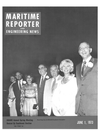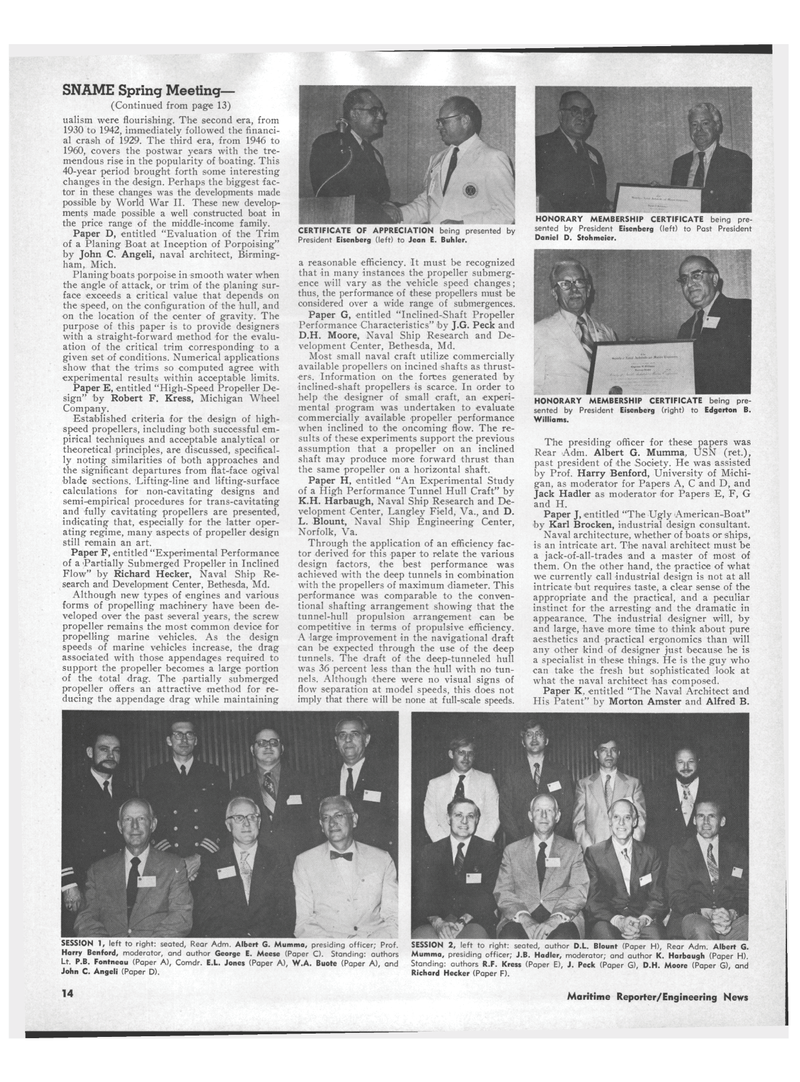
Page 12: of Maritime Reporter Magazine (June 1973)
Read this page in Pdf, Flash or Html5 edition of June 1973 Maritime Reporter Magazine
SNAME Spring Meeting— (Continued from page 13) ualism were flourishing. The second era, from 1930 to 1942, immediately followed the financi- al crash of 1929. The third era, from 1946 to 1960, covers the postwar years with the tre- mendous rise in the popularity of boating. This 40-year period brought forth some interesting changes in the design. Perhaps the biggest fac- tor in these changes was the developments made possible by World War II. These new develop- ments made possible a well constructed boat in the price range of the middle-income family.
Paper D, entitled "Evaluation of the Trim of a Planing Boat at Inception of Porpoising" by John C. Angeli, naval architect, Birming- ham, Mich.
Planing boats porpoise in smooth water when the angle of attack, or trim of the planing sur- face exceeds a critical value that depends on the speed, on the configuration of the hull, and on the location of the center of gravity. The purpose of this paper is to provide designers with a straight-forward method for the evalu- ation of the critical trim corresponding to a given set of conditions. Numerical applications show that the trims so computed agree with experimental results within acceptable limits.
Paper E, entitled "High-Speed Propeller De- sign" by Robert F. Kress, Michigan Wheel
Company.
Established criteria for the design of high- speed propellers, including both successful em- pirical techniques and acceptable analytical or theoretical principles, are discussed, specifical- ly noting similarities of both approaches and the significant departures from flat-face ogival •blade sections. Lifting-line and lifting-surface calculations for non-cavitating designs and semi-empirical procedures for trans-cavitating and fully cavitating propellers are presented, indicating that, especially for the latter oper- ating regime, many aspects of propeller design still remain an art.
Paper F, entitled "Experimental Performance of a 'Partially Submerged Propeller in Inclined
Flow" by Richard Hecker, Naval Ship Re- search and Development Center, Bethesda, Md.
Although new types of engines and various forms of propelling machinery have been de- veloped over the past several years, the screw propeller remains the most common device for propelling marine vehicles. As the design speeds of marine vehicles increase, the drag associated with those appendages required to support the propeller becomes a large portion of the total drag. The partially submerged propeller offers an attractive method for re- ducing the appendage drag while maintaining
CERTIFICATE OF APPRECIATION being presented by
President Eisenberg (left) to Jean E. Buhler. a reasonable efficiency. It must be recognized that in many instances the propeller submerg- ence will vary as the vehicle speed changes; thus, the performance of these propellers must be considered over a wide range of submergences.
Paper G, entitled "Inclined-Shaft Propeller
Performance Characteristics" by J.G. Peck and
D.H. Moore, Naval Ship Research and De- velopment Center, Bethesda, Md.
Most small naval craft utilize commercially available propellers on incined shafts as thrust- ers. Information on the fortes generated by inclined-shaft propellers is scarce. In order to help the designer of small craft, an experi- mental program was undertaken to evaluate commercially available propeller performance when inclined to the oncoming flow. The re- sults of these experiments support the previous assumption that a propeller on an inclined shaft may produce more forward thrust than the same propeller on a horizontal shaft.
Paper H, entitled "An Experimental Study of a High Performance Tunnel Hull Craft" by
K.H. Harbaugh, Naval Ship Research and De- velopment Center, Langley Field, Va., and D.
L. Blount, Naval Ship Engineering Center,
Norfolk, Va.
Through the application of an efficiency fac- tor derived for this paper to relate the various design factors, the best performance was achieved with the deep tunnels in combination with the propellers of maximum diameter. This performance was comparable to the conven- tional shafting arrangement showing that the tunnel-hull propulsion arrangement can be competitive in terms of propulsive efficiency.
A large improvement in the navigational draft can be expected through the use of the deep tunnels. The draft of the deep-tunneled hull was 36 percent less than the hull with no tun- nels. Although there were no visual signs of flow separation at model speeds, this does not imply that there will be none at full-scale speeds.
HONORARY MEMBERSHIP CERTIFICATE being pre- sented by President Eisenberg (left) to Past President
Daniel D. Stohmeier.
HONORARY MEMBERSHIP CERTIFICATE being pre- sented by President Eisenberg (right) to Edgerton B.
Williams.
The presiding officer for these papers was
Rear Adm. Albert G. Mumma, USN (ret.), past president of the Society. He was assisted by Prof. Harry Benford, University of Michi- gan, as moderator for Papers A, C and D, and
Jack Hadler as moderator for Papers E, F, G and H.
Paper J, entitled "The Ugly American-Boat" by Karl Brocken, industrial design consultant.
Naval architecture, whether of boats or ships, is an intricate art. The naval architect must be a jack-of-all-trades and a master of most of them. On the other hand, the practice of what we currently call industrial design is not at all intricate but requires taste, a clear sense of the appropriate and the practical, and a peculiar instinct for the arresting and the dramatic in appearance. The industrial designer will, by and large, have -more time to think about pure aesthetics and practical ergonomics than will any other kind of designer just because he is a specialist in these things. He is the guy who can take the fresh but sophisticated look at what the naval architect has composed.
Paper K. entitled "The Naval Architect and
His Patent" by Morton Amster and Alfred B.
SESSION 1, left to right: seated, Rear Adm. Albert G. Mumma, presiding officer; Prof.
Harry Benford, moderator, and author George E. Meese (Paper C). Standing: authors
Lt. P.B. Fontneau (Paper A), Comdr. E.L. Jones (Paper A), W.A. Buote (Paper A), and
John C. Angeli (Paper D).
SESSION 2, left to right: seated, author D.L. Blount (Paper H), Rear Adm. Albert G.
Mumma, presiding officer; J.B. Hadler, moderator; and author K. Harbaugh (Paper H).
Standing: authors R.F. Kress (Paper E), J. Peek (Paper G), D.H. Moore (Paper G), and
Richard Hecker (Paper F). 14 Maritime Reporter/Engineering News

 11
11

 13
13
